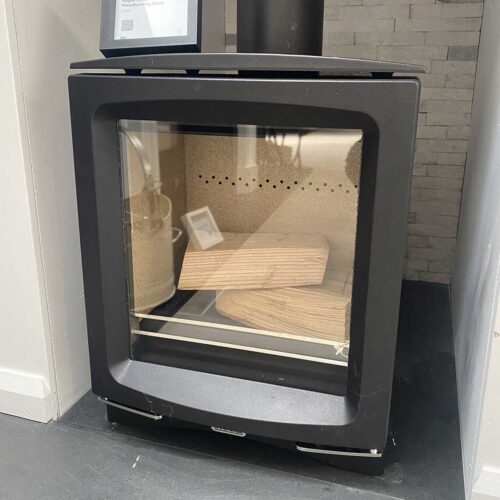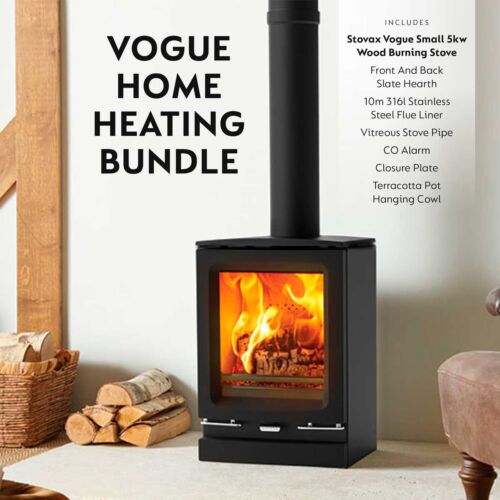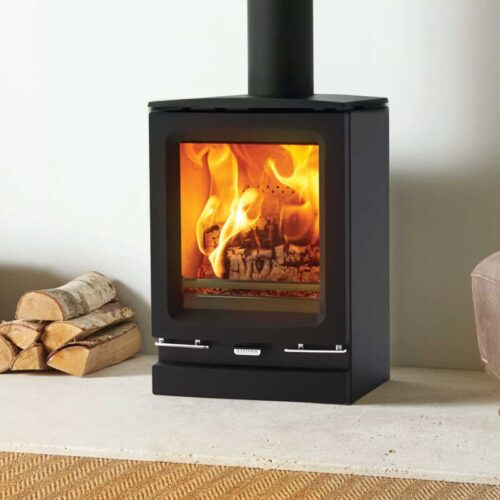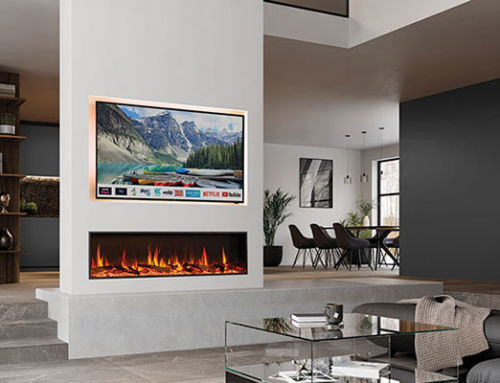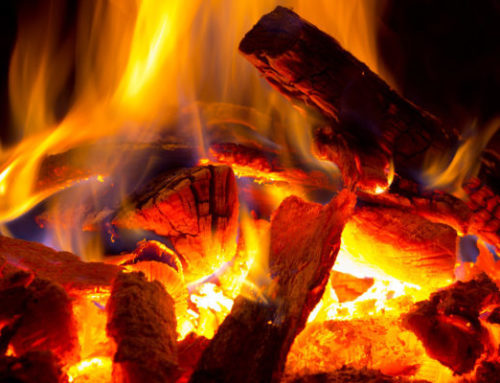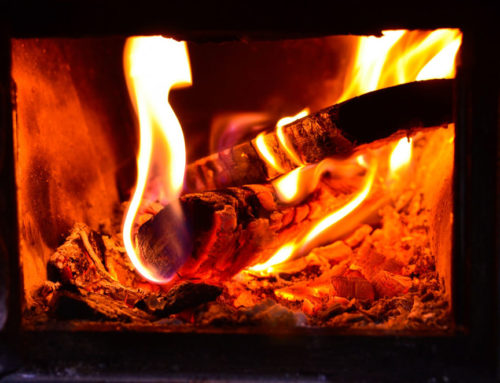All About Chimneys and Flues
The importance of well-designed chimneys and flues
Chimneys and flue systems are integral parts of the entire heating system and play an important role in the safety and efficiency of wood-burning or multi-fuel stoves. The type of chimney you install, naturally depends on the type of home, the type stove or fireplace and its location in the home. Different requirements have to be met for stoves installed against an exterior wall, or an interior wall; on the ground floor, or upper floors; near stairwells or in large open spaces, etc.
It is possible to install either a completely new twin-walled chimney system, custom-designed for houses without chimneys, or to line an existing chimney with specially designed flue liners. Steel, or stainless-steel chimneys or flue systems are recommended for wood-burning, or multi-fuel stoves because they are insulated and can handle the high temperatures. These systems can be highly decorative in themselves or can be hidden or camouflaged if it does not suit the décor of your house.
Standards of manufacture
To ensure safety standards, the UK Building Regulations, in combination with the relevant European and British Standards and Gas Safety Regulations, prescribe minimum criteria for construction and application for the chimney and flue. There are specific rules set out for the designer of heating stoves and flue systems; for the supplier and installer; and also, for landlords to ensure high standards of safety and maintenance.
At the top end of the market, flue systems are built according to very high standards that exceed the legal requirements, using only the best quality materials.
What is the difference between a chimney and a flue?
While the terms chimney and flues are often used interchangeably, they are not quite the same.
The chimney is the actual structure, or shaft that houses the flue pipes and some chimneys can accommodate more than one flue system. Chimneys can be constructed of a variety of materials, such as bricks, concrete, stone, clay, ceramic, pumice, stainless steel or steel.
The flue is the working part of the chimney. It is the duct, or pipe that lines the chimney to extract combustion gases, smoke and particles from the stove, or fireplace, to the top of the chimney and release them safely into the atmosphere.
Depending on its use, the flue system can be constructed from a variety of materials such as stainless steel, steel, ceramic or pumice.
Three main types of heating systems
Heating appliances are grouped according to their principle of combustion and ventilation systems:
- Flueless: This type of appliance does not discharge any harmful gasses, is used in open air, or the combustion air is removed from the room in another way.
- Open-Flue appliances: This type of appliance is connected to a flue that evacuates combustion gasses to the outside of the room.
- Room-Sealed Appliances: The air supply, combustion chamber and evacuation of gasses is sealed with respect to the room in which it is installed, and harmful gasses do not enter the living spaces.
How does a Modern Flue System work?
Innovative open-flue systems have been developed to be much more than just vent pipes to expel smoke from the stove to the outside. Below are some basic principles to achieve the safest and most efficient heating by means of a wood-burning, or multi-fuel stove.
Draught

Modern flue systems have been designed to keep a layer of warm air around the exhaust gasses, to prevent them from cooling down and causing a “down draught,” with the smoke flowing back into the stove and spilling into the room.
In some systems, a forced-air system, or even a blower is used to achieve an effective upward draught. Stainless steel anti-downdraught terminals have also been designed to provide weather, bird and debris protection to the chimney.
Route
The straighter and more vertical the chimney the better. It should have as few bends or turns as possible. Avoid creating 90-degree bends, flat surfaces or shelves in the system.
Feeding oxygen
If the fire does not get enough oxygen to burn the fuel efficiently, incomplete combustion will occur. This results in producing carbon monoxide and, if deprived of fresh air, copious volumes of soot. Modern flue systems draw the fresh air from outside the house in a separate duct, so that oxygen levels inside the home are not affected.
Insulation
One of the keys to a well performing wood-burning stove, is consistent insulation along the complete length of the flue. A chimney flue that is not properly insulated will be less efficient because it is important to keep the escaping air hot, so that it can rise and flow out of the chimney. Heat loss inside, or through the material of the flue, will lower the temperature of the gasses or smoke. If the smoke cools down, there is less pressure and the draught and flow are reduced. This means the smoke does not flow out properly and it also causes corrosive condensation inside the flue. Insulated flue systems usually consist of two concentric stainless-steel metal walls with insulation filling the annular space between them. Some systems have a ceramic liner, which are more effective and offer a longer life.
If chimneys are situated outside the building, they can be severely affected by cold weather, causing poor up-draught and condensation. In such an instance, a properly factory-made insulated flue system for exterior use should be installed. Existing chimneys, built of brick or masonry, should be lined with a proper flue system and the cavity between the chimney and the flue should preferably also be filled with the correct insulation.
Size: It is essential to choose a flue diameter that matches the output from the stove. Too small, and it cannot handle the job. Too large, and the up draught is insufficient. For free-standing stoves, boilers and cookers with a maximum heat output of 20KW, and that have passed the Defra requirements, the minimum flue size is 125mm. If the stove is not DEFRA approved, the minimum diameter is 150mm, but may not be used in smoke-free zones.
Retaining the heat inside the house
Closed combustion wood-burning, or multi-fuel stoves recirculate the gasses inside the stove and burn them for a second time before the remaining gasses and particles escape through the chimney. Modern flue systems are designed to aid this process and in the case of premier stoves, only 10% to 15% of the heat is lost through the chimney, compared to about 90% in the case of an open fireplace.
Manufacturing and installing Flue Systems
Flue systems can be prefabricated and then assembled on site. If this is not possible, custom-built systems can be constructed on-site with prefabricated components. However, this should only be done by suitably qualified and registered heating engineers.
Connecting Flue Pipes
Flue Pipes are specifically designed to connect the appliance to the flue or chimney and out the top. Complete internal and external systems with a wide range of fittings, such as collars, 450 and 1350 bends and elbows, offsets, connectors, tee-connectors, bird guards, anti-downdraught terminals and flexible liners are manufactured for easy assembly through locking mechanisms, or simply being pushed together. Specially designed support brackets hold them in place and ensure the whole system is strong and stable.
It is important that there should be as few bends as possible in a flue system and there must be easy access for cleaning, particularly at any change of direction in the flue. 900 bends, flat surfaces and shelves must be avoided as these can cause turbulence and smoky fires.
Joints near the heat source are usually sealed with a thermal rope and fire cement. Other joints can be sealed with heat resistant silicone sealer.
Steel and stainless-steel flue systems can usually be retrofitted where there is an existing chimney or other ventilation system. Existing chimneys must first be checked, repaired and cleaned before installing liners. The life of the liners will be reduced radically if corrosive soot or condensate deposits have not been thoroughly removed from the walls of the existing chimney flue.
Specially decorated flue systems are available to make them attractive. Otherwise, they can be hidden or camouflaged.
Flue Liners
Rigid flue liners are suitable where there are no bends in the existing chimneys to contend with.
Flexible stainless-steel liners have been designed to line existing chimneys and to take on the shape of the chimney. The liners are installed by either lowering them down, or pulling them up, the chimney. The flexible liners have been designed to easily go around most bends.
In essence, two types of flexible liners are manufactured, single- and twin walled. Single-walled stainless-steel liners are not suitable for wood-burning or multi-fuel stoves and should only be used for gas appliances. Twin skin stainless steel liners are manufactured from overlapping strips of high-grade stainless steel, which are suitable for wood-burning and multi-fuel stoves. There are two types. One type consists of two concentric pipes with an air gap. These are only suitable for internal use, or external use less than 3 metres. The other type consists of two concentric pipes of which the walls are kept separated by insulating material, preferably ceramic or other fully insulating material.
Clay, pumice and concrete liners are manufactured for wood-burning and multi-fuel stoves, but can only be used in dry, non-condensing conditions. These liners can be used because they are natural insulators but have to be surrounded with at least 100mm thick brick, block or stonework chimney and the gap in between should be filled with a suitable insulating material.
Chimney Fans
Mechanical and electrical systems have been designed to resolve problems with the natural draught in chimneys. Either forced, or induced, up-draughts are created to overcome the resistance in the flue system. Specialist advice is required before this is attempted. The system should at least be effective enough to still function safely in case of failure of the fan.
When fitting a fan in the flue system, the fan size must allow full clearance for combustion gasses against the resistance of adverse wind pressures along the entire route of the flue system.
Flue Terminals and chimney heights
Stainless steel terminals are fitted to protect the chimney and stove from strong wind or rain, bird droppings, or debris that might end up in the chimney. Terminals usually improve the flow and performance of a chimney. They are also used to resolve downdraught problems, but specialist advice is necessary to ensure there are no other problems causing the backdraught. Draft diverters can be installed in the flue system. Special down-draught diverters are also available that automatically adjust to the direction of the wind.
Terracotta chimney rain inserts are not suitable for use with gas, and some interfere with the draught of wood-burning or multi-fuel stoves.
Appropriate stainless-steel terminals can be fitted to all types of new or existing flue and chimney installations, made from stainless steel, clay, ceramic, concrete or pumice. They can be supplied either as part of the chimney system or can be obtained separately from reputable chimney terminal manufacturers and adapted as necessary.
The minimum chimney height recommended for minimum performance of wood-burning and multi fuel stoves, is 4.5 m from the top of the stove to the top of the chimney. When chimneys are near the bottom of a sloping roof or eaves, or in case of thatch roofs, the height of the chimney should be increased and properly braced, according to the advice of a specialist. The reason for this is to clear pressure zones, created by wind hitting the roof or nearby structures, like trees, and which may interfere with the up draught required by the fire in the stove.
For thatch, or other combustible roofs, specialist advice is essential and the homeowner’s insurance company must be advised of any proposed works to establish their requirements before proceeding.
Maintenance
It is imperative to check and clean the flue system at least once a year. This is best done by specialists.




